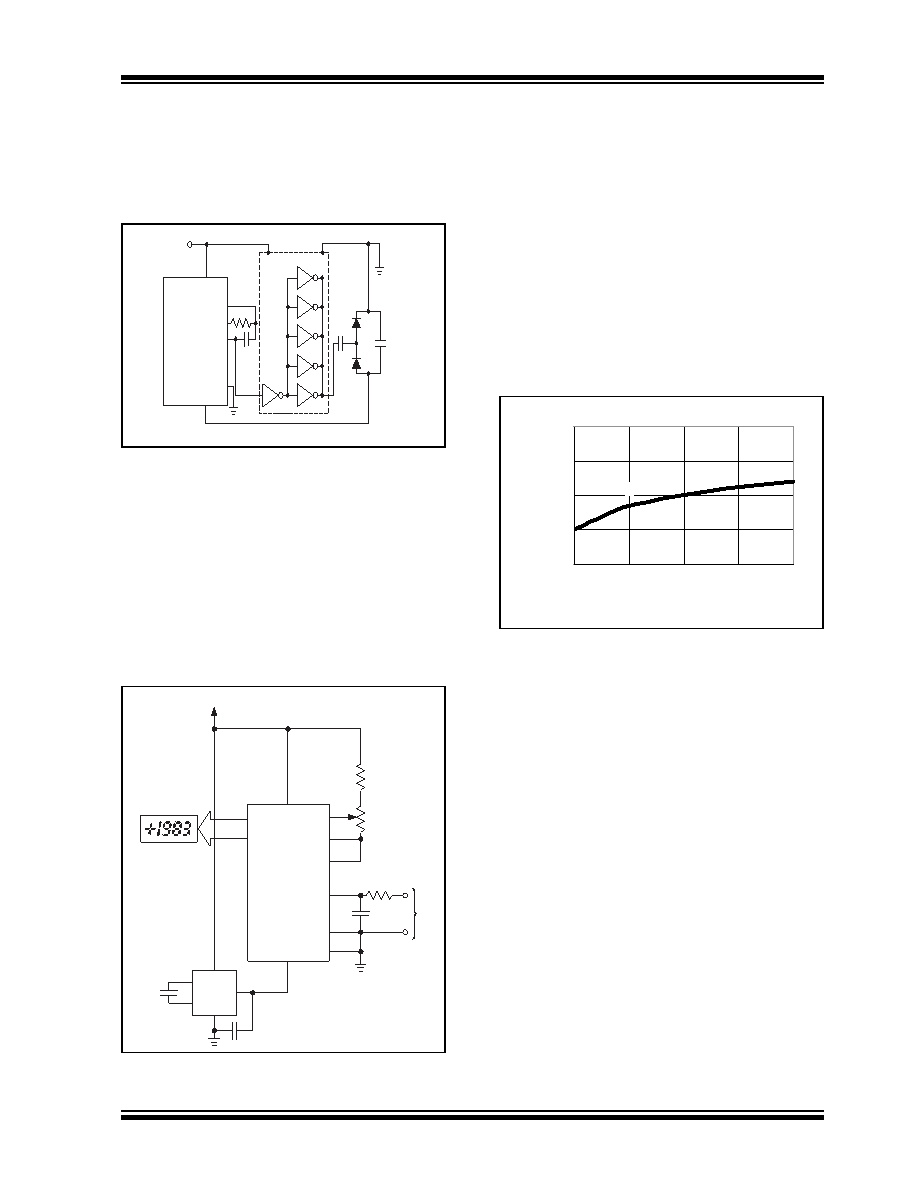- 您現(xiàn)在的位置:買賣IC網(wǎng) > PDF目錄98176 > TC7117CPI 1-CH DUAL-SLOPE ADC, PDIP40 PDF資料下載
參數(shù)資料
| 型號: | TC7117CPI |
| 元件分類: | ADC |
| 英文描述: | 1-CH DUAL-SLOPE ADC, PDIP40 |
| 封裝: | PLASTIC, DIP-40 |
| 文件頁數(shù): | 9/32頁 |
| 文件大小: | 515K |
| 代理商: | TC7117CPI |
第1頁第2頁第3頁第4頁第5頁第6頁第7頁第8頁當前第9頁第10頁第11頁第12頁第13頁第14頁第15頁第16頁第17頁第18頁第19頁第20頁第21頁第22頁第23頁第24頁第25頁第26頁第27頁第28頁第29頁第30頁第31頁第32頁

2006 Microchip Technology Inc.
DS21455C-page 17
TC7106/A/TC7107/A
9.0
POWER SUPPLIES
The TC7107A is designed to work from ±5V supplies.
However, if a negative supply is not available, it can be
generated from the clock output with two diodes, two
capacitors, and an inexpensive IC (Figure 9-1).
FIGURE 9-1:
Generating Negative Supply
From +5V
In selected applications a negative supply is not
required. The conditions to use a single +5V supply
are:
The input signal can be referenced to the center
of the Common mode range of the converter.
The signal is less than ±1.5V.
An external reference is used.
The TSC7660 DC to DC converter may be used to
generate -5V from +5V (Figure 9-2).
FIGURE 9-2:
Negative Power Supply
Generation with TC7660
9.1
TC7107 Power Dissipation
Reduction
The TC7107A sinks the LED display current and this
causes heat to build up in the IC package. If the internal
voltage reference is used, the changing chip tempera-
ture can cause the display to change reading. By
reducing the LED common anode voltage, the
TC7107A package power dissipation is reduced.
Figure 9-3 is a curve tracer display showing the rela-
tionship between output current and output voltage for
a typical TC7107CPL. Since a typical LED has 1.8 volts
across it at 7mA, and its common anode is connected
to +5V, the TC7107A output is at 3.2V (point A on
Figure 9-3). Maximum power dissipation is 8.1mA x
3.2V x 24 segments = 622mW.
FIGURE 9-3:
TC7107 Output Current vs.
Output Voltage
Notice, however, that once the TC7107A output voltage
is above two volts, the LED current is essentially con-
stant as output voltage increases. Reducing the output
voltage by 0.7V (point B in Figure 9-3) results in 7.7mA
of LED current, only a 5 percent reduction. Maximum
power dissipation is only 7.7mA x 2.5V x 24 = 462mW,
a reduction of 26%. An output voltage reduction of 1
volt (point C) reduces LED current by 10% (7.3mA) but
power dissipation by 38% (7.3mA x 2.2V x 24 =
385mW).
Reduced power dissipation is very easy to obtain.
Figure shows two ways: either a 5.1 ohm, 1/4 watt
resistor or a 1 Amp diode placed in series with the dis-
play (but not in series with the TC7107A). The resistor
will reduce the TC7107A output voltage, when all 24
segments are “ON,” to point “C” of Figure . When
segments turn off, the output voltage will increase. The
diode, on the other hand, will result in a relatively
steady output voltage, around point “B.”
TC7107A
V+
OSC1
OSC2
OSC3
GND
V-
V+
CD4009
0.047
μF
1N914
10
μF –
+
V- = -3.3V
GND
VIN-
VIN
VREF+
VREF-
COM
+5V
LED
DRIVE
36
1
35
32
31
30
26
V+
V-
21
TC7660
3
10
μF
+
10
μF
+
2
8
5
(-5V)
TC7107A
4
VIN+
C
B
A
6.000
7.000
8.000
9.000
10.000
2.00
2.50
3.00
3.50
4.00
O ut put V o lt a ge ( V )
Ou
tp
ut
C
u
rr
en
t
(m
A
)
相關(guān)PDF資料 |
PDF描述 |
|---|---|
| TC7116RCPL | 1-CH 13-BIT DUAL-SLOPE ADC, PDIP40 |
| TC7116CLW723 | 1-CH 13-BIT DUAL-SLOPE ADC, PQCC44 |
| TC7116CKW723 | 1-CH 13-BIT DUAL-SLOPE ADC, ACCESS, PQFP44 |
| TC7116ARCPL | 1-CH 13-BIT DUAL-SLOPE ADC, ACCESS, PDIP40 |
| TC7116ACKW713 | 1-CH 13-BIT DUAL-SLOPE ADC, PQFP44 |
相關(guān)代理商/技術(shù)參數(shù) |
參數(shù)描述 |
|---|---|
| TC7117CPL | 功能描述:LED顯示驅(qū)動器 3.5 digit A/D RoHS:否 制造商:Micrel 數(shù)位數(shù)量:5 片段數(shù)量: 安裝風格:SMD/SMT 封裝 / 箱體:PLCC-44 工作電源電壓:4.75 V to 11 V 最大電源電流:10 mA 最大工作溫度:+ 85 C 最小工作溫度:- 40 C 封裝:Tube |
| TC7117IJL | 功能描述:LED顯示驅(qū)動器 3-1/2 Digit A/D w/ Hold RoHS:否 制造商:Micrel 數(shù)位數(shù)量:5 片段數(shù)量: 安裝風格:SMD/SMT 封裝 / 箱體:PLCC-44 工作電源電壓:4.75 V to 11 V 最大電源電流:10 mA 最大工作溫度:+ 85 C 最小工作溫度:- 40 C 封裝:Tube |
| TC7117RCPL | 功能描述:LED顯示驅(qū)動器 w/Hold RoHS:否 制造商:Micrel 數(shù)位數(shù)量:5 片段數(shù)量: 安裝風格:SMD/SMT 封裝 / 箱體:PLCC-44 工作電源電壓:4.75 V to 11 V 最大電源電流:10 mA 最大工作溫度:+ 85 C 最小工作溫度:- 40 C 封裝:Tube |
| TC711A | 制造商:Thomas & Betts 功能描述:Fittings Connector 0.5inch Steel |
| TC711A-RT | 制造商:Thomas & Betts 功能描述:Fittings Connector 0.5inch Steel |
發(fā)布緊急采購,3分鐘左右您將得到回復(fù)。